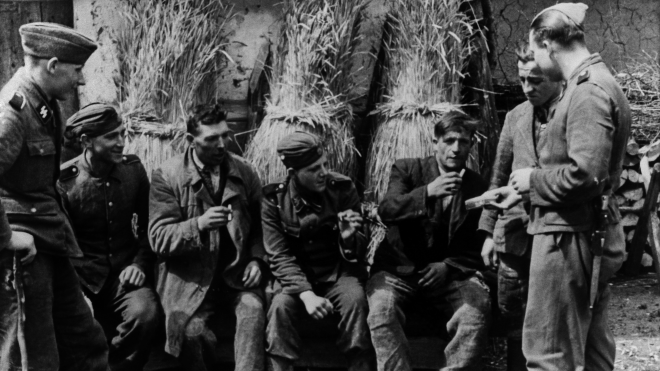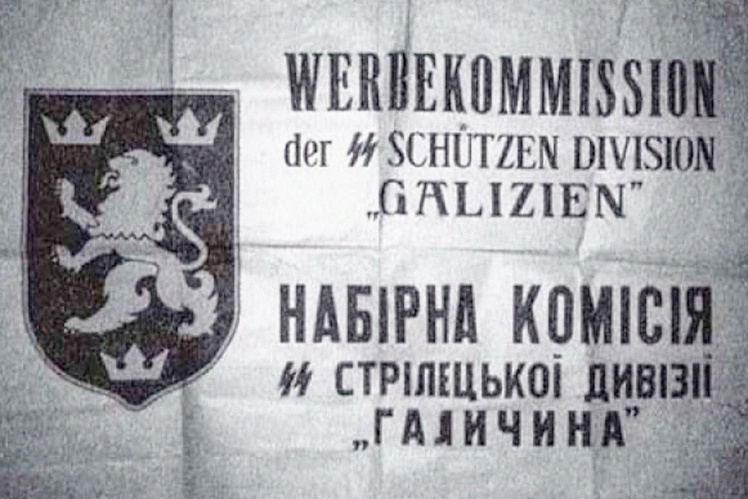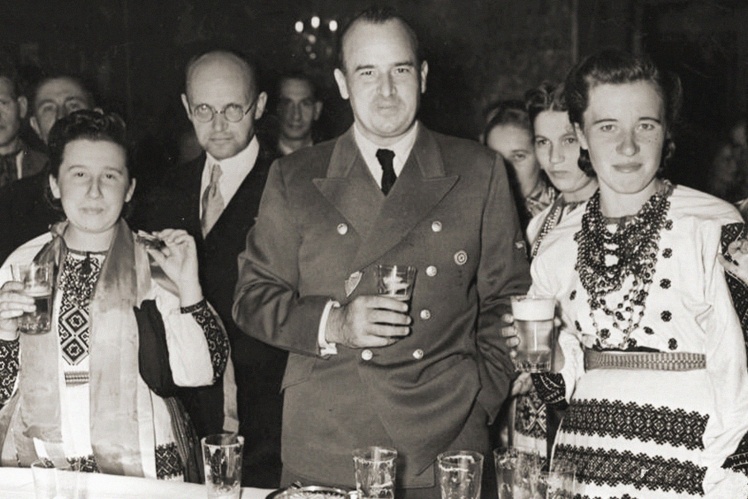What was the name of the Division? The Division changed its name several times during its short history. On the day of its creation, April 28, 1943, it was listed as the Rifle Division of the SS "Galicia". At the time when the first recruits were recruited, from May 30 to October 1943, it was called the Voluntary Division of the SS "Galicia". During training from October 22, 1943 to June 27, 1944 — the 14th Galician SS Volunteer Division.
During the hostilities and before the reformation after the Battle of Brody, from June 27 to November 12, 1944, it was the 14th Waffen (military) SS Grenadier (infantry) Division (1st Galician). After reformation from November 12, 1944 to April 25, 1945 — "14th SS Military Infantry Division (Ukrainian No. 1)." And from April 25 to May 8, 1945 — the 1st Ukrainian Division of the Ukrainian National Army.
A sign at the recruiting station recruiting volunteers to the Galicia Division, 1943.
Wikimedia
What is the difference between the SS Division and the Waffen-SS? Classic SS Divisions were formed from Germans or from those who were considered close to them by blood, such as Scandinavians. And the Waffen-SS, according to Hitler himself, are ordinary soldiers. The Waffen-SS also created military formations from foreigners, because only citizens of the Reich could serve in the Wehrmacht, the Armed Forces of Nazi Germany. However, the soldiers of such formations, including Ukrainian Divisional soldiers, received the same benefits and privileges as the Germans.
Is such a Division a purely Ukrainian case of collaboration with Germany? The first such formations were created in Czechoslovakia, then in the countries of Benelux and Scandinavia. Of the approximately 40 Divisions of the Waffen-SS, almost half consisted of the population of the occupied and allied states with Germany — Croats, Latvians, Estonians, Hungarians, Romanians, French, Italians, Finns, Belarusians and Russians.
Soldiers of the 1st Galician SS Division take the oath, 1943.
Wikimedia
Who created the Division and who was recruited into it? The initiator from the German side was SS General Otto Wechter, who in 1942 became the governor of the Galicia District. Wechter, an Austrian by origin, did not perceive Galicians as Ukrainians, but as former subjects of the Austro-Hungarian Empire. In the leadership of the Third Reich, this initiative was personally overseen by SS Reichsführer (leader) Heinrich Himmler.
Heinrich Himmler (in the foreground) with Otto Wechter and other German officers in front of the formation of the "Galicia" SS Division, 1943.
Wikimedia
On the Ukrainian side, the idea of creating a Division was supported by the Ukrainian Central Committee (UCC) headed by Ukrainian historian, geographer, public figure and former soldier of the Ukrainian Galician Army (UGA) Volodymyr Kubiyovych.
Initially, only residents of the modern Lviv, Ivano-Frankivsk, and Ternopil regions were recruited into the Division. Later — people from other regions, captured Red Army soldiers, and Ostarbeiters. The first volunteers underwent a strict selection process. In the end, out of almost 82,000 volunteers, 13,000 were enrolled in the Division. In the summer of 1943, they went to training camps. The highest command positions throughout the Divisionʼs existence were occupied by Germans.
Governor-General Hans Frank with members of the Ukrainian delegation in Krakow, to his left is the head of the Central Committee Volodymyr Kubiyovych, 1943. UIA postcard, 1940-1950s.
Why were there so many volunteers? Thanks to a powerful and well-thought-out campaign. The Germans emphasized first of all the fight against the Bolsheviks. German propaganda did not even have to try very hard. During the Soviet occupation of 1939-1941, Western Ukraine, in particular Galicia, learned what collectivization, mass repressions and deportations are. It was enough to simply open prisons filled with thousands of corpses of people who were hastily shot by the NKVD authorities before the retreat of the Red Army in 1941. The German regime in Galicia followed a more "soft" position in the occupation policy. Nazi crimes in other territories were, of course, covered up. At the beginning of 1943, the Red Army went on the offensive on the Eastern Front, Soviet power was returning to Galicia — this also motivated recruits.
Leaflet about the creation of the Galicia Division, 1943.
The volunteers, who came from predominantly Greek Catholic families, were not convinced Nazis. The German leadership even allowed, as an exception, to include chaplains from priests of the Ukrainian Greek Catholic Church in the Division.
The Ukrainian Central Committee presented the Division as an opportunity to continue the Ukrainian national struggle for independence in 1917-1921. The traditions of the Legion of Ukrainian Sich Riflemen, UGA, troops of the Peopleʼs Republic of Ukraine went into action. There were even parallels between the abbreviation SS and sniper riflemen. Veterans and former commanders of these units were involved. They had authority among young men aged 17-19, who became the basis of the first recruitment to the Division. And Volodymyr Kubiyovych, a former lieutenant of the UGA, was the first to apply to join the Division. However, he was predictingly commissioned due to his age and health.
Ukrainian Greek-Catholic priest, Administrator of the Apostolic Exarchate of Lemkivshchyna Oleksandr Malynovskyi with volunteers of the 1st Galician Division, 1943.
Wikimedia
And what did Organisation of Ukrainian Nationalists and Ukrainian Insurgent Army think about the Division? In 1940, the organization of Ukrainian nationalists split into two wings — radical revolutionaries led by Stepan Bandera and conservatives led by Andrii Melnyk. "Melnykivtsi" supported the idea of creating a Division, while "Banderivtsi" were categorically against it. The Ukrainian Insurgent Army was created in parallel, at the end of 1942 — at the beginning of 1943. But agitators of the UCC, on the contrary, urged not to join the UIA, saying that "you cannot gain independence in the forest with one rifle."
Members of the UIA headquarters in the Ternopil region, 1940s.
Wikimedia
There were also those who joined the Division to gain experience and weapons, and then fled to the UIA. But there was no mass desertion. For some reason, the German command, just in case, sent recruits to training camps far from Galicia — deep into Germany and other occupied European countries.
Did the Germans promise an independent Ukrainian state? In the first years of the occupation, any actions in this direction were severely suppressed. It was allowed to form a national Division only in the spring of 1943 — after the Germans had lost at Stalingrad, in Africa, and on other fronts. Himmler personally ordered to ban the use of the word "Ukrainian" in the name of the Division.
When the German troops retreated from Galicia, the Division was renamed "Ukrainian". And in the spring of 1945, Germans could promise anything. Even to officially recognize the Ukrainian National Committee (essentially another Ukrainian government in exile) and allow it to create the Ukrainian National Army, which included the former Galicia Division. Now the soldiers have already openly sworn allegiance to the Ukrainian people and promised to "renew the fight for Ukrainian statehood." All this happened on April 25, 1945, a few weeks before the surrender of Germany in the Second World War.
UIA postcard, 1940-1950s.
How did the Ukrainian supporters of the Division plan to win independence? According to researchers, the plan looked something like this. In the early 1920s, the Ukrainians lost primarily because they did not have an equipped, trained and combat-ready army. Most of all, there was a lack of qualified commanders. The necessary experience in a short time could be gained only in the regular army.
Under those conditions, it could only be the German or Soviet army. The Bolsheviks fell away, the Germans remained. The German military machine, especially in the first half of the Second World War, was famous for its professionalism and high standards of training. Guerrilla struggle in the spirit of the UIA made no sense without large-scale help from outside, and the Ukrainians didnʼt have such support. If the Germans refuse to create an independent Ukraine, trained and hardened Ukrainian combat units can become an argument for negotiations, for example, with the British.
UIA postcard, 1940-1950s.
Some historians consider this idea of Volodymyr Kubiyovych and his supporters a political adventure and a mistake that cost the lives of "thousands of idealistic young people who could have benefited Ukraine in another way."
What oath did the volunteers take? There are three known oath texts. The first oath was taken in the summer of 1943 during the first recruitment. It was standard for all foreign volunteers: "I swear to fight communism under the leadership of Adolf Hitler as supreme commander." In the fall of 1944, a new text of the oath appeared specifically for the Galicia Division: "I swear under the leadership of Adolf Hitler as the Supreme Commander-in-Chief to fight for Ukraine, for its liberation from the Bolsheviks." And the third is the oath of the Ukrainian National Army on April 25, 1945, Hitler is no longer mentioned in it.
Otto Vechter speaks before the volunteers of the Galicia SS Division in Lviv, July 1943.
Wikimedia
Was the Division used as cannon fodder in the battle near Brody? In the summer of 1944, it was already a staffed and trained unit in the German army. In terms of people and equipment, the Soviet troops prevailed several times. The German troops, as well as the Galicia Division, also lost many soldiers. About 70% of almost 11,000 Ukrainian divisional soldiers died or were captured. About three thousand broke out of the encirclement and returned to the German location — in the fall of 1944, the Division was formed anew on their basis. Some of those who left the circle joined the UIA.
After Brody, the Division was sent to Slovakia to fight with Slovak partisans. In January 1945, she was transferred to Yugoslavia for operations against the communist partisans of Josip Broz Tito. In the spring of 1945, it fought in Austria. And on May 8, after the capitulation of Germany, the 1st Ukrainian Division of the Ukrainian National Army left its position at the front and surrendered to British troops.
Soldiers of the 1st Galician SS Division with an anti-tank gun, March 1944.
Wikimedia
Why were they not handed over to the Soviet Union? The Yalta Conference agreements played a role here, according to which the citizenship of the participants in hostilities as of 1939 was taken into account. And at that time, most of the Divisional officers were citizens of Poland. The Catholic Church intervened and tried to intercede for its parishioners. In 1947, more than eight thousand members of the Division were transported to Britain. Subsequently, some of them emigrated to Canada, the USA, Australia, Argentina and other countries.
What about war crimes? The Galicia Division was never convicted — neither at the Nuremberg Trials nor by any other tribunal. The British inspection also found no evidence. The last large-scale investigation into this issue was conducted by a Canadian government commission in the 1980s. No evidence was found that it was Ukrainian Divisional officers who committed war crimes. However, the commission used mainly German archives, it was not possible to gain access to Soviet archives.
What is the attitude towards the Division now? Ambiguous both in the West and in Ukraine itself. Therefore, historians suggest focusing on educational work and public discussions "about this complex page of Ukrainian history.”
Translated from Ukrainian by Anton Semyzhenko.
If you want more texts on historical topics, support the Babel editorial office: in hryvnia , 🔸 in cryptocurrency , 🔸 Patreon , 🔸 PayPal: [email protected]



